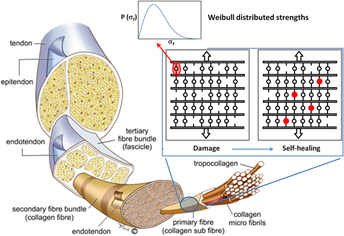Published online by Cambridge University Press: 16 December 2014

One of the defining properties of biological structural materials is self-healing, i.e., the ability to undergo long-term reparation after instantaneous damaging events, but also after microdamage due to repeated load cycling. To correctly model the fatigue life of such materials, self-healing must be included in fracture and fatigue laws, and related codes. Here, we adopt a numerical modelization of fatigue cycling of self-healing biological materials based on the hierarchical fiber bundle model and propose modifications in Griffith's and Paris' laws to account for the presence of self-healing. Simulations allow us to numerically verify these modified expressions and highlight the effect of the self-healing rate, in particular, for collagen-based materials such as human tendons and ligaments. The study highlights the effectiveness of the self healing process even for small healing rates and provides the possibility of improving the reliability of predictions of fatigue life in biomechanics, e.g., in sports medicine.